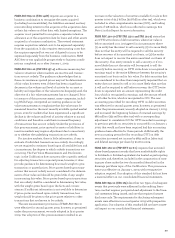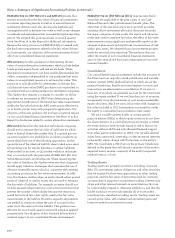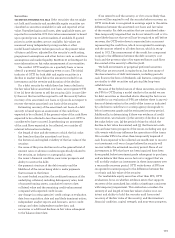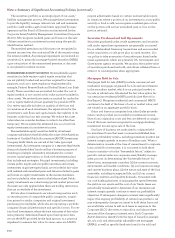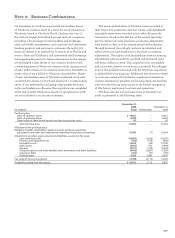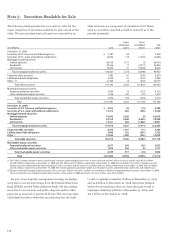Wells Fargo 2009 Annual Report Download - page 105
Download and view the complete annual report
Please find page 105 of the 2009 Wells Fargo annual report below. You can navigate through the pages in the report by either clicking on the pages listed below, or by using the keyword search tool below to find specific information within the annual report.
the weighted-average coupon rate of such loans no longer
meeting our ongoing investment criteria. Upon the issuance
of such directives, we immediately transfer these loans to the
MHFS portfolio at the lower of cost or market value.
Loans Held for Sale
Loans held for sale (LHFS) are carried at the lower of cost or
market value (LOCOM) or at fair value for certain portfolios
that we intend to hold for trading purposes, and are generally
valued on an aggregate portfolio basis. For loans carried at
LOCOM, gains and losses on loan sales (sales proceeds minus
carrying value) are recorded in noninterest income, and direct
loan origination costs and fees are deferred at origination of
the loan and are recognized in noninterest income upon sale of
the loan. The fair value of LHFS is based on what secondary
markets are currently offering for portfolios with similar
characteristics.
Loans
Loans are reported at their outstanding principal balances
net of any unearned income, charge-offs, unamortized deferred
fees and costs on originated loans and premiums or discounts
on purchased loans, except for certain PCI loans which are
recorded at fair value on their purchase date. See the “Purchased
Credit-Impaired Loans” section in this Note for our accounting
policy for PCI loans. Unearned income, deferred fees and costs,
and discounts and premiums are amortized to interest income
over the contractual life of the loan using the interest method.
We offer a portfolio product known as relationship ARMs
that provides interest rate reductions to reward eligible banking
customers who have an existing relationship or establish a
new relationship with Wells Fargo. Accordingly, this product
offering is generally underwritten to certain Company guide-
lines rather than secondary market standards and is typically
originated for investment. At December 31, 2009 and 2008, we
had $12.5 billion and $15.6 billion, respectively, of relationship
ARMs held for investment. Originations, net of collections and
proceeds from the sale of these loans are reflected as investing
cash flows consistent with their original classification.
Loans also include direct financing leases that are recorded
at the aggregate of minimum lease payments receivable plus
the estimated residual value of the leased property, less
unearned income. Leveraged leases, which are a form of direct
financing leases, are recorded net of related nonrecourse debt.
Leasing income is recognized as a constant percentage of
outstanding lease financing balances over the lease terms.
Loan commitment fees are generally deferred and amor-
tized into noninterest income on a straight-line basis over the
commitment period.
NONACCRUAL LOANS We generally place loans on nonaccrual
status when:
• the full and timely collection of interest or principal
becomes uncertain;
• they are 90 days (120 days with respect to real estate 1-4
family first and junior lien mortgages and auto loans) past
due for interest or principal (unless both well-secured and
in the process of collection); or
• part of the principal balance has been charged off and no
restructuring has occurred.
PCI loans are written down at acquisition to an amount
estimated to be collectible. Accordingly, such loans are no
longer classified as nonaccrual even though they may be
contractually past due, because we expect to fully collect the
new carrying values of such loans (that is, the new cost basis
arising out of purchase accounting).
Generally, consumer loans not secured by real estate or
autos are placed on nonaccrual status only when part of the
principal has been charged off. These loans are charged off
or charged down to the net realizable value of the collateral
when deemed uncollectible, due to bankruptcy or other fac-
tors, or when they reach a defined number of days past due
based on loan product, industry practice, country, terms and
other factors.
When we place a loan on nonaccrual status, we reverse the
accrued unpaid interest receivable against interest income
and account for the loan on the cash or cost recovery method,
until it qualifies for return to accrual status. Generally, we
return a loan to accrual status when (a) all delinquent interest
and principal become current under the terms of the loan
agreement or (b) the loan is both well-secured and in the
process of collection and collectibility is no longer doubtful.
Loan Charge-Off Policies
For commercial loans, we generally fully or partially charge
down to the fair value of collateral securing the asset when:
• management judges the asset to be uncollectible;
• repayment is deemed to be protracted beyond reasonable
time frames;
• the asset has been classified as a loss by either our internal
loan review process or external examiners;
• the customer has filed bankruptcy and the loss becomes
evident owing to a lack of assets; or
• the loan is 180 days past due unless both well secured and
in the process of collection.
For consumer loans, our charge-off policies are as follows:
- FAMILY FIRST AND JUNIOR LIEN MORTGAGES We generally
charge down to the net realizable value when the loan is 180
days past due.
AUTO LOANS We generally fully or partially charge down to
the net realizable value when the loan is 120 days past due.
UNSECURED LOANS (CLOSED END) We generally charge-off
when the loan is 120 days past due.
UNSECURED LOANS (OPEN END) We generally charge-off when
the loan is 180 days past due.
CREDIT CARD LOANS We generally fully charge-off when the
loan is 180 days past due.
OTHER SECURED LOANS We generally fully or partially charge
down to the net realizable value when the loan is 120 days
past due.








